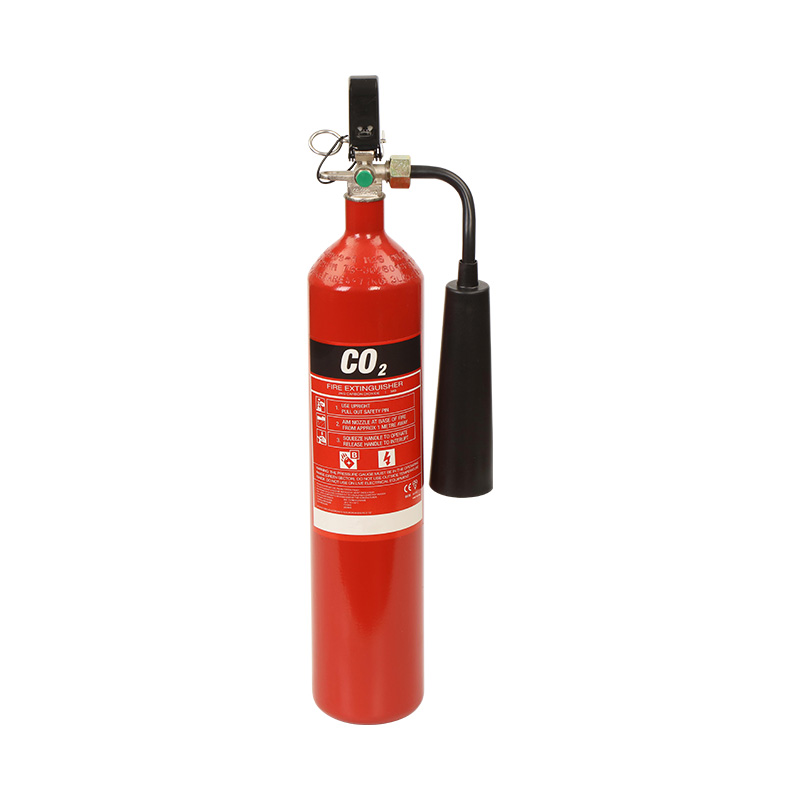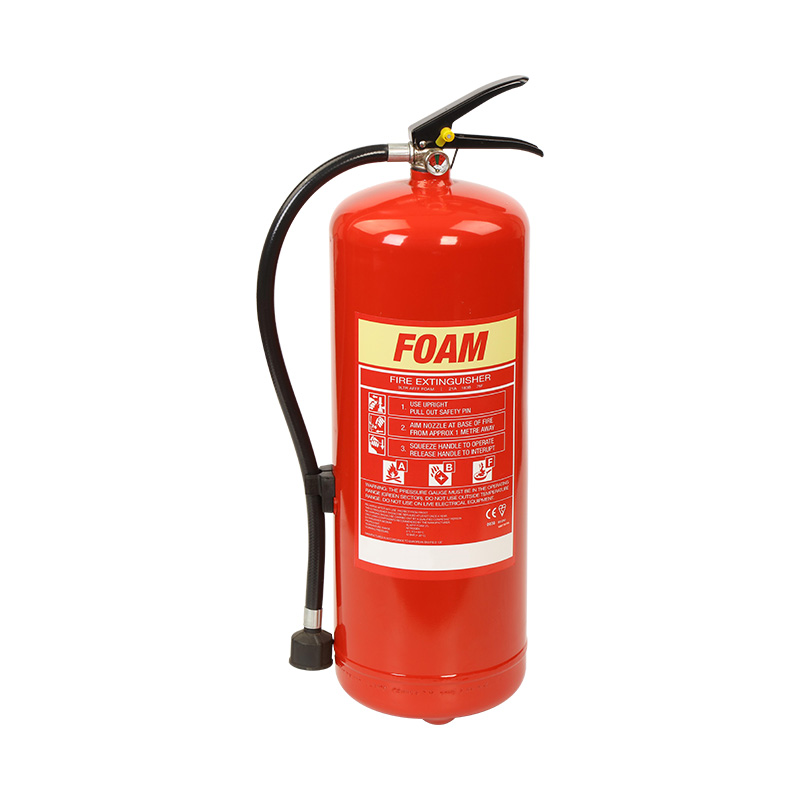Fire extinguishers are essential tools for protecting lives and property from unexpected fires. Having the right type of fire extinguisher readily available can prevent minor incidents from turning into major disasters.
Among the various types available, CO2 fire extinguishers and dry chemical fire extinguishers are two of the most commonly used. Each type is designed to tackle specific classes of fires, and understanding their differences is crucial for effective fire safety.
What is a CO2 Fire Extinguisher?
Definition:
A CO2 fire extinguisher is a portable fire suppression device that uses carbon dioxide gas to extinguish fires. It is primarily designed for electrical fires (Class C) and flammable liquid fires (Class B). CO2 extinguishers are widely used in environments with sensitive electronic equipment because they leave no residue.

How CO2 Extinguishers Work:
- Mechanism:
- The extinguisher releases pressurized carbon dioxide stored in liquid form.
- When discharged, CO2 rapidly expands into a gas, displacing oxygen around the fire.
- Without oxygen, the fire cannot sustain combustion and is effectively extinguished.
- Temperature Effect: CO2 is extremely cold when released (around -57°C / -70°F), which can also help cool the fire source.
Ideal Uses for CO2 Extinguishers:
- Class B fires: Flammable liquids like gasoline, paint, and solvents.
- Class C fires: Electrical fires, including wiring, servers, and appliances.
Advantages of CO2 Extinguishers:
- Leaves no residue, preventing damage to sensitive equipment.
- Safe for electrical fires since CO2 is non-conductive.
- Minimal cleanup required after use.
Disadvantages of CO2 Extinguishers:
- Limited range: Typically 3–8 feet (1–2.5 meters).
- Oxygen displacement risk: Can be dangerous in small, enclosed spaces.
- Less effective on Class A fires: Inefficient on wood, paper, and fabric.
Key Parameters of CO2 Extinguishers:
| Parameter | Typical Range / Value | Notes |
|---|---|---|
| Fire classes | B, C | Not recommended for Class A fires |
| Discharge range | 3–8 ft (1–2.5 m) | Shorter than dry chemical extinguishers |
| Discharge time | 8–30 seconds | Depends on size (2–15 lb cylinders typical) |
| Storage pressure | 800–900 psi | Liquid CO2 under high pressure |
| Operating temperature | -30°C to 50°C (-22°F to 122°F) | Standard environmental range |
| Residue | None | Leaves surfaces clean |
| Safety concerns | Oxygen displacement | Risk in confined spaces |
What is a Dry Chemical Fire Extinguisher?
Definition:
A dry chemical fire extinguisher uses a fine powder to suppress fires by interrupting the chemical reaction that sustains combustion. These extinguishers are highly versatile and can be designed for Class A, B, and C fires, depending on the type of dry chemical used.
Types of Dry Chemical Extinguishers:
- Ordinary Dry Chemical: Primarily used for Class B and C fires. Suitable for flammable liquids and electrical fires but limited on Class A fires.
- Multipurpose Dry Chemical (ABC): Designed for Class A, B, and C fires. Can handle ordinary combustibles, flammable liquids, and electrical fires.

How Dry Chemical Extinguishers Work:
- The powder coats the fuel, separating it from oxygen.
- It also interrupts the chemical chain reaction of the fire.
- This mechanism allows it to quickly stop flames and prevent re-ignition.
Ideal Uses for Dry Chemical Extinguishers:
- Class A fires: Wood, paper, cloth, and other ordinary combustibles.
- Class B fires: Flammable liquids like gasoline, oils, and paints.
- Class C fires: Electrical fires involving appliances, wiring, and machinery.
Advantages of Dry Chemical Extinguishers:
- Versatile: Can handle multiple fire classes depending on type.
- Longer discharge range: Typically 10–20 feet (3–6 meters).
- Effective on most fire types: Quickly suppresses flames and reduces re-ignition risk.
Disadvantages of Dry Chemical Extinguishers:
- Leaves residue: Can be corrosive and damage equipment.
- Respiratory irritation: Powder may cause coughing or discomfort.
- Cleanup required: Surfaces must be cleaned after discharge.
Key Parameters of Dry Chemical Extinguishers:
| Parameter | Typical Range / Value | Notes |
|---|---|---|
| Fire classes | A, B, C | Depends on type (ABC multipurpose or ordinary BC) |
| Discharge range | 10–20 ft (3–6 m) | Longer than CO2 extinguishers |
| Discharge time | 10–25 seconds | Varies with cylinder size (2–20 lb typical) |
| Operating temperature | -20°C to 60°C (-4°F to 140°F) | Standard environmental range |
| Residue | Yes (corrosive powder) | Requires cleanup, can damage sensitive equipment |
| Safety concerns | Respiratory irritation | Use with care in enclosed spaces |
| Mechanism | Chemical reaction interruption | Coats fuel and breaks combustion chain |
Key Differences
Fire Classes
CO2 Fire Extinguisher: Primarily effective on Class B (flammable liquids) and Class C (electrical fires). Less effective on Class A fires.
Dry Chemical Fire Extinguisher: Ordinary dry chemical: mainly for Class B and C fires. Multipurpose (ABC) dry chemical: effective on Class A, B, and C fires.
Residue
CO2: Leaves no residue, ideal for sensitive equipment.
Dry Chemical: Leaves corrosive powder, requiring cleanup.
Environmental Impact
CO2: Can contribute to greenhouse gas emissions if sourced unsustainably. Low local environmental risk during use.
Dry Chemical: Chemicals can be environmentally hazardous if not disposed of properly.
Safety Considerations
CO2: Oxygen displacement risk in confined areas. Extremely cold discharge can cause frostbite.
Dry Chemical: Respiratory irritation if inhaled. Powder can obscure vision temporarily in enclosed spaces.
Applications: Where to Use Each Type
CO2 Extinguishers: Server rooms and data centers, laboratories, kitchens (for grease fires).
Dry Chemical Extinguishers: Garages and workshops, offices, homes.
Range and Effectiveness
| Parameter | CO2 Fire Extinguisher | Dry Chemical Fire Extinguisher |
|---|---|---|
| Discharge range | 3–8 ft (1–2.5 m) | 10–20 ft (3–6 m) |
| Fire classes | B, C | A, B, C (ABC type) |
| Residue | None | Corrosive powder |
| Discharge mechanism | Oxygen displacement | Chemical reaction interruption |
| Environmental impact | Low local, potential CO2 emissions | Chemical residue disposal required |
| Safety risks | Suffocation in confined spaces, frostbite | Respiratory irritation, visibility obstruction |
| Cleanup required | Minimal | Yes, thorough cleaning needed |
Cost Comparison
Initial Cost
CO2 Fire Extinguisher: Generally higher upfront cost due to high-pressure cylinder.
| Cylinder Size | Typical Cost Range | Notes |
|---|---|---|
| 2–5 lb | Moderate | Small office or home use |
| 10–15 lb | Higher | Labs, server rooms |
Dry Chemical Fire Extinguisher: Lower initial cost for standard ABC units.
| Cylinder Size | Typical Cost Range | Notes |
|---|---|---|
| 2–5 lb | Lower | Compact home or office use |
| 10–20 lb | Moderate | Garages, workshops |
Maintenance Costs
CO2: Requires visual inspection, weighing, and hydrostatic testing every 5–12 years. Moderate long-term maintenance costs.
Dry Chemical: Requires visual inspection, pressure gauge checks, powder condition checks, and hydrostatic testing. Slightly higher maintenance due to potential powder replacement and cleanup.
Long-Term Considerations
CO2: Longer shelf life, minimal cleanup.
Dry Chemical: Powder may settle, requiring agitation or replacement, and cleanup costs after use.
| Parameter | CO2 Fire Extinguisher | Dry Chemical Fire Extinguisher |
|---|---|---|
| Initial cost | Moderate to High | Low to Moderate |
| Cylinder sizes | 2–15 lb | 2–20 lb |
| Maintenance | Moderate | Slightly higher |
| Refills | Less frequent | May require powder replacement |
| Cleanup cost | Minimal | Moderate to High |
| Shelf life | Long | Long, powder may settle over time |
Maintenance and Inspection
CO2 Fire Extinguishers
- Visual Inspection: Check for dents, corrosion, or leaks. Ensure hoses and discharge horn are intact.
- Weighing: Monthly or scheduled weighing ensures proper CO2 charge.
- Hydrostatic Testing: Every 5–12 years depending on cylinder size.
- Pressure Check: Not applicable; relies on weight.
- Operational Readiness: Safety pin and tamper seal intact.
| Parameter | Typical Value / Requirement | Notes |
|---|---|---|
| Visual inspection | Monthly | Check for damage or leaks |
| Weight check | Monthly or scheduled | Ensure proper CO2 charge |
| Hydrostatic testing | 5–12 years | High-pressure cylinder safety |
| Pressure gauge | N/A | CO2 relies on weight |
| Tamper seal | Intact | Confirms readiness |
Dry Chemical Fire Extinguishers
- Visual Inspection: Check for dents, corrosion, hose/nozzle damage.
- Pressure Gauge Check: Needle should remain in green zone.
- Powder Condition: Ensure powder is not compacted; shake if necessary.
- Hydrostatic Testing: Every 5–12 years.
- Operational Readiness: Safety pin and tamper seal intact.
| Parameter | Typical Value / Requirement | Notes |
|---|---|---|
| Visual inspection | Monthly | Check for damage or corrosion |
| Pressure gauge | Monthly | Needle in green zone |
| Powder condition | Monthly | Ensure free-flowing powder |
| Hydrostatic testing | 5–12 years | Cylinder safety |
| Tamper seal | Intact | Confirms readiness |
Regulations and Standards
NFPA 10
Standard for portable fire extinguishers, covering selection, installation, inspection, maintenance, and testing.
- Selection based on fire class hazards.
- Accessible installation with clear signage.
- Monthly visual inspections.
- Annual maintenance and periodic hydrostatic testing.
- User training for proper operation.
Local Fire Codes
- Additional requirements for placement, type, and quantity may apply.
- Enforced by fire authorities.
- Examples: minimum extinguishers per square footage, specific types for industrial hazards, clear signage and proper mounting height.
| Parameter | CO2 Fire Extinguisher | Dry Chemical Fire Extinguisher |
|---|---|---|
| NFPA 10 classification | Class B, C | Class A, B, C (ABC type) |
| Monthly inspection | Required | Required |
| Annual maintenance | Required | Required |
| Hydrostatic testing | Every 5–12 years | Every 5–12 years |
| Placement requirements | Accessible, visible | Accessible, visible |
| Training requirements | Users trained | Users trained |
| Local code considerations | Occupancy dependent | Occupancy dependent |

 English
English 中文简体
中文简体 Español
Español












 VR Catalogue
VR Catalogue
